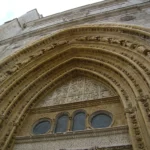In the heart of Seville, Spain, the Plaza de España stands not only as a dazzling spectacle of Neo-Mudéjar and Renaissance Revival architecture but also as a living narrative of Andalusian pride and global connections. Walking this semi-circular plaza offers a unique glance into Spain’s architectural ingenuity and historical layers, perfectly crafted by Aníbal González for the Ibero-American Exposition of 1929. For lovers of elegant design and public squares, the Plaza de España invites an immersive cultural experience complemented by nearby charming eateries, convenient transport, and tranquil green spaces.
Table of Contents
A Showcase of Architectural Harmony and Symbolism
The Plaza de España’s layout deserves particular attention: its expansive semi-circle mirrors a supreme gesture towards the Guadalquivir River, symbolizing Spain extending its arm to connect with its former territories. This embrace incorporates tiled alcoves, each representing a Spanish province, creating a richly decorated mosaic that acts like a history book in ceramic. The bridges that cross the ditch signify four ancient kingdoms of Spain, while the grand central fountain injects a soothing rhythm.
Ornate colonnades frame the square, their red bricks and brilliant azulejos complementing each other with a vivid dialogue of textures and colors. The soaring towers mark the site’s importance, drawing the eye upwards in a silent tribute to Renaissance verticality mingled with local traditions. Every balustrade, every baluster, feels carefully crafted – not as mere decoration but as a testament to Seville’s artisanal heritage.
Evolution of Style and Craftsmanship
Rather than a cold monument, Plaza de España is a conversation between styles-Neo-Mudéjar draws on Moorish roots, while Renaissance elements anchor the plaza in European classicism. This hybrid style taps into Andalusia’s layered history, inviting visitors to reflect on cultural fusion and artistic evolution.
After enjoying Seville’s grand Plaza de España, you might appreciate the distinct architectural grandeur of Delhi’s Qutub Minar, another remarkable monument blending history and artistry.
Historical Tapestry Behind the Plaza
Constructed to celebrate the Ibero-American Exposition, Plaza de España functioned as a showcase for Spain’s past achievements and hopes for international collaboration. Beyond its exhibition purpose, it symbolizes Spain’s commitment to modernity in the early 20th century, blending artistry with pioneering urban planning.
An often overlooked fact is its role as a cinematic icon. The plaza’s grandeur and unique shape have attracted filmmakers, embedding Seville’s allure into global visual culture.
Perfect Moments to Visit and Practical Advice
To appreciate the full splendor of Plaza de España, timing is essential. Early mornings bring a soft glow that bathes the ceramic alcoves in gentle light, ideal for photography. Late afternoons offer warmer tones coupled with fewer crowds, perfect for contemplative strolls.
Weekdays tend to be less busy, allowing for uninterrupted admiration of architectural details. Spring and autumn balance mild climate with vibrant surroundings, making these seasons particularly pleasant.
Visitor Protocols and Entrance Notes
Fortunately, Plaza de España remains a public space freely accessible without mandatory reservations. However, guided tours enrich understanding by unveiling hidden stories behind tiles, sculptures, and design choices. Booking a tour in advance through local agencies or the official Seville tourism portal is recommended during peak seasons.
Reaching the Plaza: Directions and Transport Options
Situated within Maria Luisa Park, Plaza de España is easy to reach from Seville’s city center. From the historic core, a 15-minute walk along shaded avenues will lead you to the entrance. Public buses also serve stops near the park, providing convenient access. For travelers arriving by train or plane:
- From Santa Justa train station, take a short taxi ride or bus line heading toward the city center and Maria Luisa Park.
- Seville Airport connects via shuttle buses to central points, from which a taxi or pedal taxi will swiftly bring you to the plaza.
The plaza’s location within Maria Luisa Park also means those who enjoy cycling or electric scooters have a scenic and open path leading directly to this architectural jewel.
Nearby Comfort and Tasteful Flavors
Close to Plaza de España, visitors will find charming guesthouses, boutique accommodations, and cozy inns that blend modern comfort with Andalusian character. This proximity allows extended visits, especially beneficial for those wishing to immerse themselves in the plaza’s changing light and atmosphere.
Just a short stroll away, local tapas bars serve traditional delights like jamón ibérico, gazpacho, and fiery pimientos de padrón. Enjoying these flavors amid Seville’s streets enhances the sensory journey, offering not just visual but culinary artistry.
Photographing the Plaza: Tips for Enthusiasts
For lovers of architectural photography, the interplay of light and shadow at the plaza unveils new perspectives throughout the day. Approaching the site from different angles reveals its layered composition-from panoramic shots capturing the full sweep to close-ups focusing on the intricate tiles and wrought iron.
Time your visit during golden hours and consider using the bridges as foreground elements to emphasize depth. Also, the occasional rowboat rides in the moat provide dynamic shots blending human activity with architectural form.
Official Resource for Planning Visits
For detailed visitor information, events, and official updates, consult the official tourism website of Seville where Plaza de España is featured prominently. Feel free to check its website.

- Plaza de España, Seville – 2013.07 – panoramio by rheins on Wikimedia Commons – cc by 3.0
